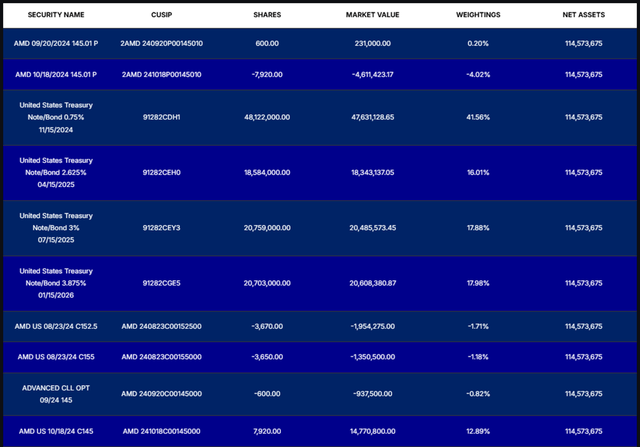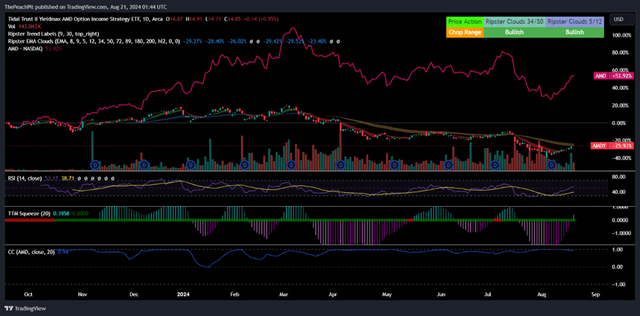
primeimages/E+ via Getty Images
YieldMax AMD Option Income Strategy (NYSEARCA:AMDY) is an actively managed ETF with the sole purpose of generating income for the ETF holder through options trading on a single stock, Advanced Micro Devices (AMD). AMDY was launched on September 18, 2023, with the sole intention of offering shareholders an alternative strategy to owning AMD through a derivatives trading strategy, allowing for investors to potentially maximize earnings on the single-name stock. As an actively managed fund, AMDY holds a gross expense ratio of 99bps, on par with other strategies offered by YieldMax. Given the income-generating component of AMDY and passive exposure to AMD, I recommend AMDY with a BUY rating with a maximum allocation of 5%.
As a disclaimer, I am bullish on AMD given the company’s competitive nature in the GPU space. The firm is actively developing their next-generation GPU, the MI400, to compete with Nvidia’s (NVDA) Blackwell GPU. You can review my previous research here:
AMD Is About To Accelerate Their Growth Strategy (Earnings Preview)
AMD Q4 Earnings Preview: Growth Is Far From Over
How Does AMDY Work?
The portfolio managers overseeing AMDY have a singular goal in mind in managing the strategy: generate income to shareholders. The portfolio is managed through short positions in both call and put options, meaning that the fund sells both calls and puts for AMD shares in order to generate monthly income. The fund also holds US treasury notes as collateral against the options strategy in order to maintain a certain level of cash income in the portfolio.

Corporate Reports
Reviewing the holdings, it appears that the fund is bullish with a short put position around the strike price of $145/share for AMD shares with expiration dates around September 20, 2024, and long a call position with the same strike price that expires on October 18, 2024. The fund is also short call positions with an expiration date of August 23, 2024, at the strike prices of $152.5 and $155.
As part of the ETF’s strategy, AMDY has a monthly distribution that varies month-to-month based on the strategy’s performance. AMDY holds a 35.10% forward distribution rate based on the most recent monthly distribution of $0.4306/share. This high distribution rate brings a certain appeal to the ETF, especially considering that AMD shares do not distribute a cash dividend.
Net of distributions, AMDY is directionally tied to the underlying asset with near 1:1 correlation. This suggests that AMDY’s share price will trend directionally with AMD net of distributions, potentially based on investors’ perception of share price performance.

TradingView
Despite this factor, I do not believe AMDY is necessarily meant to be actively traded as one would trade a leveraged strategy like TQQQ (TQQQ) or GraniteShares 2x Long AMD Daily ETF (AMDL). This can potentially create lackluster results for investors as they may end up only participating in directional share price value as opposed to the high-yielding income component that the ETF has to offer. One other component that may lead to lackluster results for active traders is liquidity risk. AMDY has a mere $115mm in assets under management, with 143k in average daily trading volumes. This factor may lead to less optimal spreads for traders if they’re seeking to enter and exit positions in AMDY on a regular basis, leading to a higher cost to trading shares.
Risk Involved In Holding AMDY
The fund’s strategy caps its potential gains if AMD shares increase in value, meaning that the fund has limitations on profit taking given its short positions. In addition to this, the fund has the potential to suffer losses if AMD shares decline in value and may not be offset by income received by the fund. Given that the fund trades directionally with the underlying AMD stock, this can pose an inherent risk to holding AMDY if shares were to experience a significant downturn. Likewise, holders of AMDY may not realize the full potential of the underlying AMD share appreciation. Given that the fund does not directly invest in AMD shares, these factors may be amplified during times of high volatility.
There’s one other element to take into consideration when investing in AMDY: treasury note exposure. Many analysts are anticipating the Fed to cut the Federal Funds rate 3x this year as a result of the slowing inflation rate. If this is the case, there could be some positive exposure in the fund given that 94% of the holdings are short-term treasuries. Though this would be a long shot, this could provide the assets some uplift as a result of the rate cuts.
Conclusion
AMDY is a single-stock options strategy that investors could buy into to gain exposure to AMD derivatives without the need to actively manage an options portfolio. This ETF provides a substantial amount of cash flow as a result of the management strategy of underwriting calls & put options while holding short-term treasuries as collateral. Though this strategy holds some inherent risks in the instance of significant price volatility of the underlying asset, especially to the downside, I believe AMDY can be a useful vehicle for buy-and-hold investors seeking exposure to AMD while accumulating income. I recommend AMDY with a BUY recommendation with a maximum allocation of 5%.
Comments